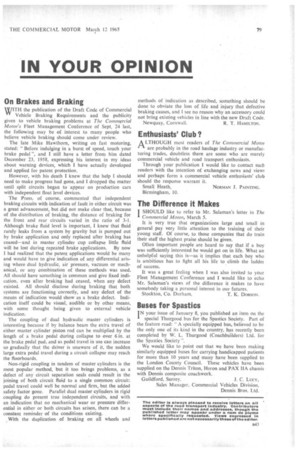IN YOUR OPINION
Page 81

If you've noticed an error in this article please click here to report it so we can fix it.
On Brakes and Braking
WITH the publication of the Draft Code of Commercial Vehicle Braking Requirements and the publicity given to vehicle braking problems at The Commercial Motor's Fleet Management Conference of Sept. 24 last, the following may be of interest to many people who believe vehicle braking should come under review.
The late Mike Hawthorn, writing on fast motoring, stated: "Before indulging in a burst of speed, touch your brake pedal ", and I still have a letter from him dated December 23, 1958, expressing his interest in my ideas about warning devices, which I have actually developed and applied for patent protection.
However, with his death I knew that the help I should need to make progress had gone, and I dropped the matter until split circuits began to appear on production cars with independent float level devices, The Press, of course, commented that independent braking circuits with indication of fault in either circuit was a great advancement, but did not make clear that, because of the distribution of braking, the distance of braking for the front and rear circuits varied in the ratio of 3-1. Although brake fluid level is important, I knew that fluid rarely leaks from a system by gravity but is pumped out by brake application and only replaced after braking has ceased—and in master cylinder cup collapse little fluid will be lost during repeated brake applications. By now I had realized that the patent applications would be many and would have to give indication of any differential arising where dual hydraulic, air pressure, vacuum or mechanical, or any combination of these methods was used. All should have something in common and give fixed indication, even after braking had ceased, when any defect existed. All should disclose during braking that both systems are functioning correctly, and any defect of the means of indication would show as a brake defect. Indication itself could be visual, audible or by other means, with some thought being given to external vehicle indication.
The coupling of dual hydraulic master cylinders is interesting because if by balance beam the extra travel of either master cylinder piston rod can be multiplied by the length of a brake pedal during collapse to over 6 in. at the brake pedal pad, and as pedal travel in use can increase so gradually that the driver is unaware of it, the sudden large extra pedal travel during a circuit collapse may reach the floorboards.
Non-rigid coupling in tandem of master cylinders is the most popular method, but it too brings problems, as a defect of any circuit separation seals could result in the joining of both circuit fluid to a single common circuit; pedal travel could well be normal and firm, but the added safety factor gone. Parallel dual master cylinders in rigid coupling do present true independent circuits, and with an indication that no mechanical wear or pressure differential in either or both circuits has arisen, there can be a constant reminder of the conditions existing.
With the duplication of braking on all wheels and methods of indication as described, something should be done to obviate the loss of life and injury that defective braking causes, and I see no reason why an accessory could not bring existing vehicles in line with the new Draft Code.
Newquay, Cornwall. R. T. HAMILTON.
Enthusiasts' Club?
j—kLTHOUGH most readers of The Commercial Moto; are probably in the road haulage industry or manufacturing trades, doubtless there are some who are merely commercial vehicle and road transport enthusiasts. Through. your publication I would like to contact such readers with the intention of exchanging news and views and perhaps form a commercial vehicle enthusiasts' club should the response warrant it.
Small Heath, NORMAN J. PAINTING. Birmingham, 10.
The Difference it Makes
SHOULD like to refer to Mr. Salaman's letter in The Commercial Motor, March 5.
It is very true that organizations large and small in general pay very little attention to the training of their young staff. Of course, to those companies that do train their staff the highest praise should be given.
Often important people are heard to say that if a boy was sufficiently interested he would get on in life. What an unhelpful saying this is—as it implies that each boy who is ambitious has to fight all his life to climb the laddei of success.
It was a great feeling when I was also invited to your Fleet Management Conference and I would like to echo Mr. Salaman's views of the difference it makes to have somebody taking a personal interest in our futures.
Stockton, Co. Durham, T. K. DOBSON.
Buses for Spastics
I N your issue of January 8, you published an item on the special Thurgood bus for the Spastics Society. Part of the feature read: "A specially equipped bus, -believed to be the only one of its kind in the country, has recently been completed by W. L. Thurgood (Coachbuilders) Ltd. for the Spastics Society ", We would like to point out that we have been making similarly equipped buses for carrying handicapped patients for more than 10 years and many have been supplied to the London County Council. These vehicles have been supplied on the Dennis Triton, Heron and PAX HA chassis with Dennis composite coachwork, Guildford, Surrey, J. C. Lucy, Sales Manager. Commercial Vehicles Division, Dennis Bros. Ltd.
























































































































